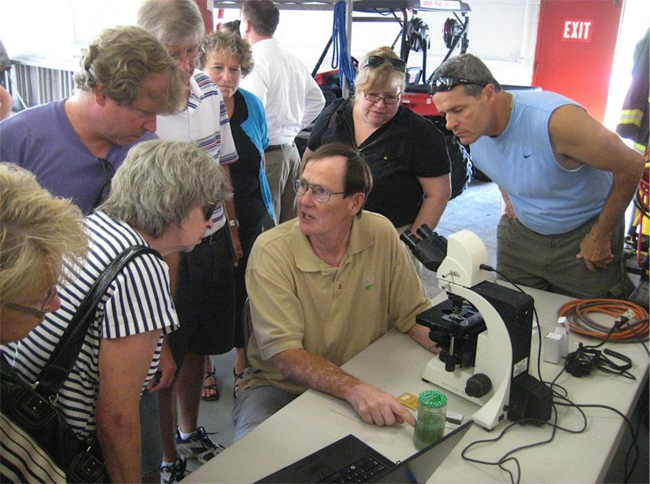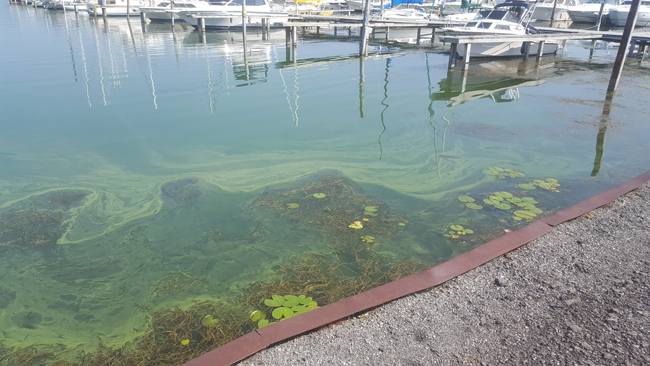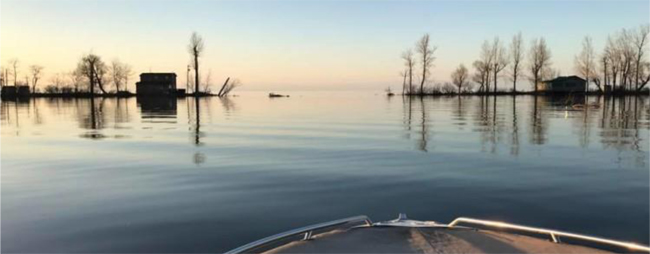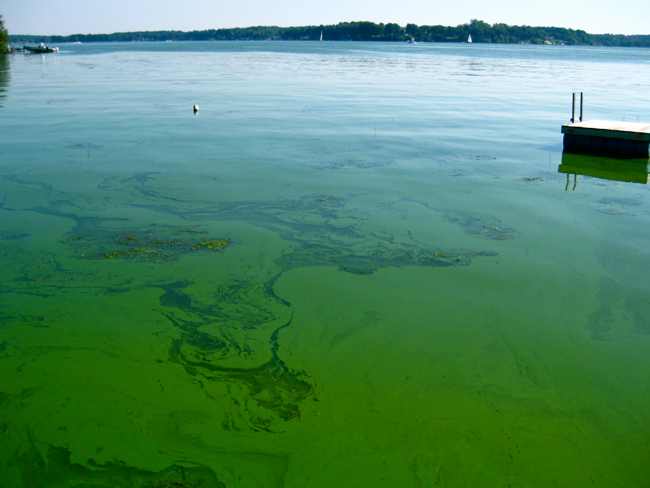
Boyer conducts a training session with Sodus Bay residents as part of Save Our Sodus’s Day of Science on Sodus Point. Credit: Save Our Sodus.
— By Chris Gonzales, Freelance Science Writer, New York Sea Grant
Syracuse, NY, May 24, 2021 - At peak season, two weeks before Labor Day, no one swam in the water. No one sat in the restaurants. The streets were empty. No, it wasn't COVID-19. Instead, a thick blue-green film coated the water in Sodus Bay, a popular tourist destination on Lake Ontario.
That was 2010. Several severe harmful algal blooms (HABs) occurred in the bay, one of Lake Ontario’s largest. In the years that followed, more blooms came. Since 2014, we’ve seen a decrease of toxic Microcystis-dominated events.
Microcystis are several species of freshwater bacteria, all in the same genus, that cause HABs. They’re also called blue-green algae, being known to coat the water with a thick blue-green film. The algae can be harmful to humans, causing diarrhea and allergic reactions such as difficulty breathing. Furthermore, it can be fatal to pets. Scientists have been collecting information that could tell us if and when an outbreak of the algae will occur again.

This 2016 photo shows the extent of a Microcystis bloom in one of the marinas of Sodus Bay, Lake Ontario, New York. Credit: Great Lakes Research Consortium.
Prevention Tactics
For this lakeshore community, boats and marinas are a way of life. Researchers have examined several scenarios related to the design of marinas. Usually these harbors are a hybrid of manmade and natural structures and have solid piers with moorings for leisure craft and small boats. The solid piers calm the water and make it easier to dock. New designs call for specially-constructed piers to maximize water flow and exchange between moorings. These could reduce HABs in a marina.
There’s been high awareness of HABs in the area among lakeshore homeowners.
Yet, according to results from a survey that scientists conducted as part of a New York Sea Grant-funded research project, this hasn’t always translated into an eagerness to pay for mitigation solutions.
“Extensive study on Sodus Bay highlighted the complexity of harmful algal blooms,” said Gregory Boyer, director of the Great Lakes Research Consortium and emeritus professor of biochemistry at SUNY College of Environmental Science and Forestry. “It’s not a simple case of excess nutrients, or just warming summers, but a complex interaction of multiple events, including wind, weather, nutrients and localized circulation. All are necessary for a bloom to occur.”

A breach in Crescent Beach was caused by high water levels. This breach, shown in April of 2017, opened up a new circulation pattern for Sodus Bay. Credit: Joanne VanEtten.
Recent Changes in the Bay
A unique set of weather conditions likely caused the 2010 bloom. Boyer, writing a report in the summer of 2020, didn’t see such an extreme HAB as being as likely in the near term. But longer term, that’s another story.
In April of 2017, high water levels came to Lake Ontario, which caused a breach in Crescent Beach—the 7,500 foot long barrier beach separating the lake from the bay. This breach opened up new circulation patterns for Sodus Bay. Meanwhile, water levels rose, and attention among the public shifted away from HABs. But from 2010 to 2018, Boyer took samples of the water that tell us a lot about these freshwater algae and the problems they cause.
Scientists set out three monitoring buoys to assess water quality in the bay. They also conducted weekly sampling for HABs, nutrients, and general water quality parameters. These were done at Oak Park Marina, Katlynn Marina, and the Town Beach.
Boyer and his partners also conducted a survey of the business community about willingness to pay for various remediation solutions for HABs in the bay. One would be a one-time payment to widen the channel, the entry to the bay from the lake, to increase water circulation. Another option would be an annual tax to pay for buffers around tributaries to the bay.
Concerns about HABs remain high and there is some willingness to take steps that give some assurance that HABs would not return to the bay.

Undergraduate volunteer Kaela Natwora deploys the Sodus Bay Center buoy. Credit: Michael Satchwell.
Looking Ahead
As part of their study, scientists performed calculations that forecast how much the bay water temperature might change if the lake channel to the bay were deepened.
These changes would make it so significant quantities of water could come into the bay from nearshore lake waters, not just the watershed that feeds into the bay.
The scientists conducted various possible scenarios, modeling water flow in the marina. They found that constructing the marina piers to allow water circulation beneath them would reduce risk of HABs. While solid piers make it easier to dock boats, it creates more stable water conditions favorable to the development of cyanobacterial blooms.
Boyer said that the model they developed to study HABs in Sodus Bay now serves as the basis for a much larger model being developed to study the entire Lake Ontario nearshore ecosystem.
“The human dimension is difficult to capture,” Boyer said. “There is a high awareness and willingness to pay for HAB remediation when blooms are present, but that willingness can be rapidly replaced by other concerns when blooms are absent. In the specific case of Sodus Bay, concern over rising water levels rapidly replaced concerns about HABs. That will likely remain the case until another major HAB event brings that concern back to the forefront.”

This Microcystis bloom started in Sodus Bay but moved outwards into Lake Ontario proper. From this view, one is looking out at the lake towards Toronto. Credit: Save Our Sodus Inc.

A picture taken in 2010 of a Microcystis bloom in Sodus Bay, Lake Ontario, New York. Credit: Jay Ross.
References
Perri, K., Sullivan, J., & Boyer, G. (2015). Harmful algal blooms in Sodus Bay, Lake Ontario: A comparison of nutrients, marina presence, and cyanobacterial toxins. Journal of Great Lakes Research. 41(2) 326-337. ISSN 0380-1330, https://doi.org/10.1016/j.jglr.2015.03.022
Karamigolbaghi, M. et al. (2019). Circulation and mixing in Sodus Bay due to water exchange with Lake Ontario. Journal of Great Lakes Research. 45(6) 1090-1102. ISSN 0380-1330, https://doi.org/10.1016/j.jglr.2019.09.020
More Info: New York Sea Grant
New York Sea Grant (NYSG), a cooperative program of Cornell University
and the State University of New York (SUNY), is one of 34 university-based
programs under the National Oceanic and Atmospheric Administration’s
National Sea Grant College Program.
Since 1971, NYSG has represented a statewide network of integrated
research, education and extension services promoting coastal community
economic vitality, environmental sustainability and citizen awareness
and understanding about the State’s marine and Great Lakes resources.
Through NYSG’s efforts, the combined talents of university scientists
and extension specialists help develop and transfer science-based
information to many coastal user groups—businesses and industries,
federal, state and local government decision-makers and agency managers,
educators, the media and the interested public.
The program maintains Great Lakes offices at Cornell University, SUNY
Buffalo, SUNY Oswego and the Wayne County Cooperative Extension office
in Newark. In the State's marine waters, NYSG has offices at Stony Brook
University in Long Island, Brooklyn College and Cornell Cooperative
Extension in NYC and Kingston in the Hudson Valley.
For updates on Sea Grant activities: www.nyseagrant.org has RSS, Facebook, Twitter, Instagram, and YouTube links. NYSG offers a free e-list sign up via www.nyseagrant.org/nycoastlines for its flagship publication, NY Coastlines/Currents, which is published quarterly.